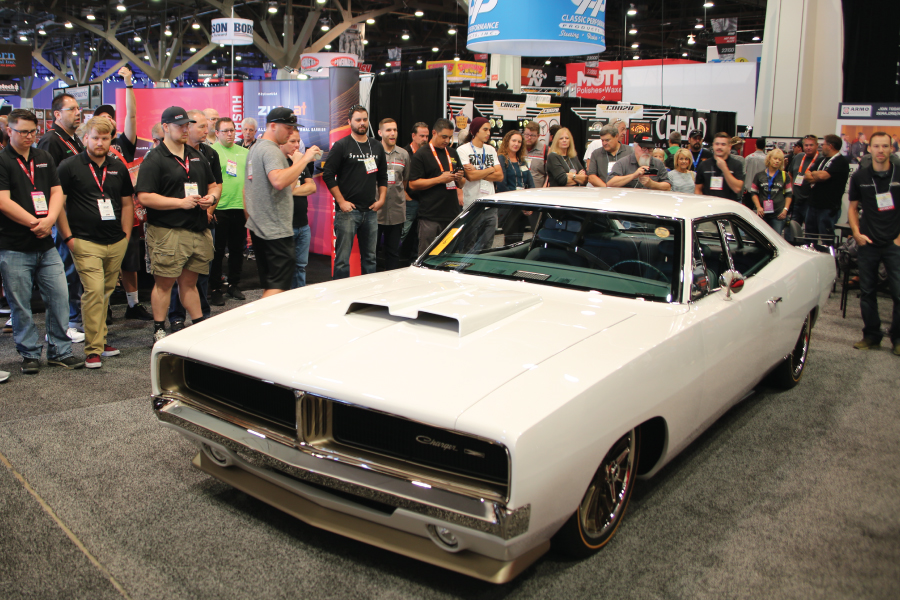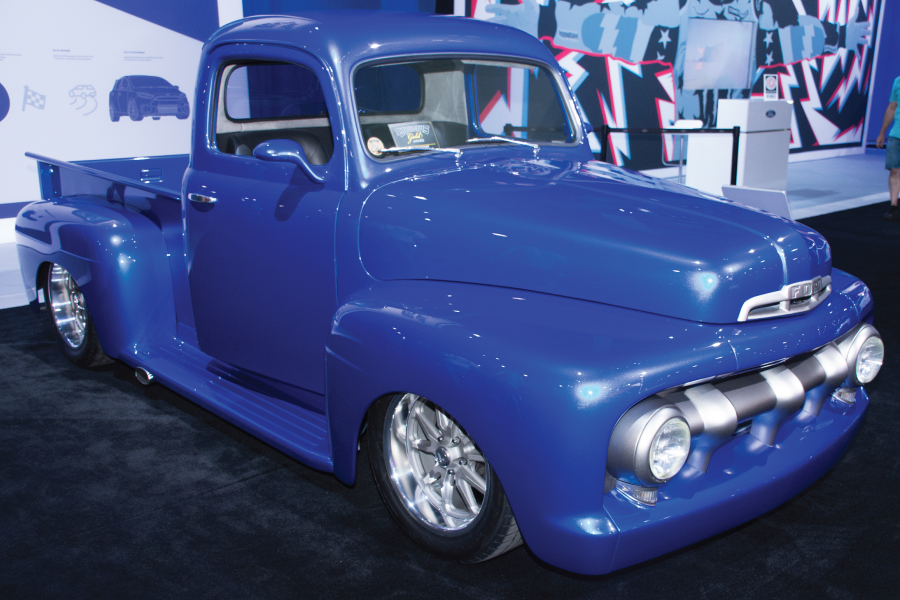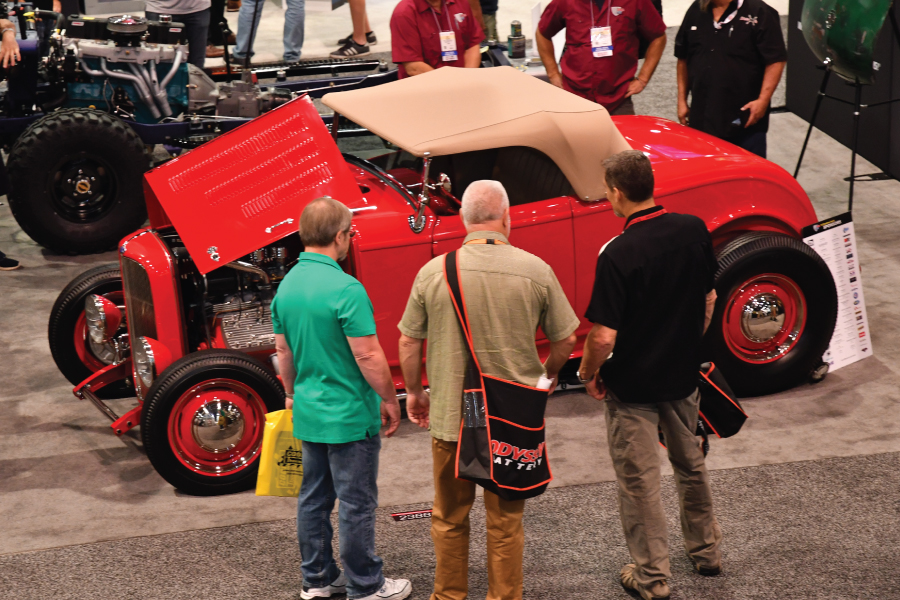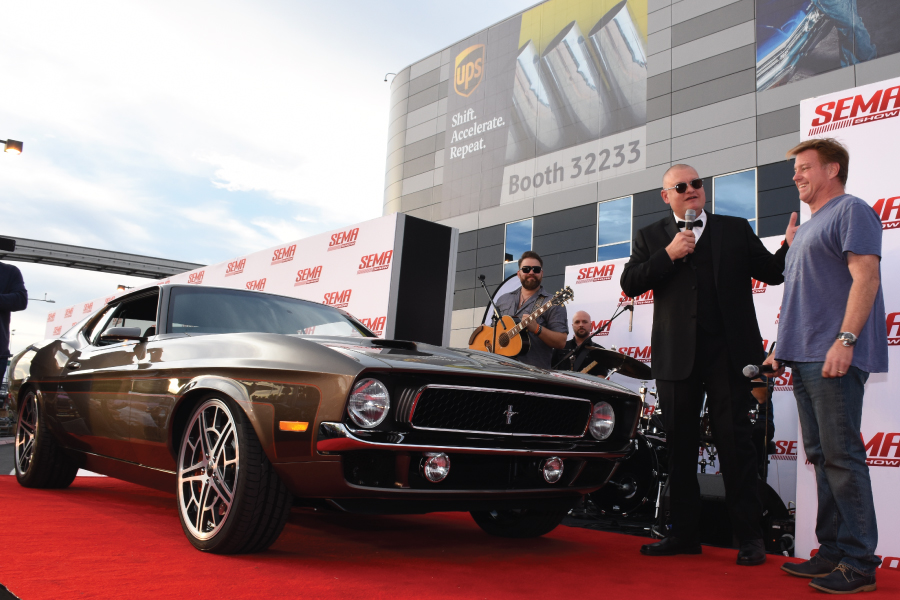SEMA News—June 2018
BUSINESS
The New Rules of Hot Rodding
Trends and Opportunities in Today’s Marketplace
 Late-model musclecars like this ’69 Charger by BBT Fabrications are growing in popularity and broadening the scope of what’s accepted as a hot rod. Late-model musclecars like this ’69 Charger by BBT Fabrications are growing in popularity and broadening the scope of what’s accepted as a hot rod. |
Among the most popular destinations at the SEMA Show, Hot Rod Alley is home to exhibitors who design and manufacture products intended to add reliability, performance and comfort to American classics. The hot-rod niche has seen significant growth in recent years, and it’s currently estimated to be a $1.26-billion industry, according to the Hot Rod Industry Alliance’s “2017 Biannual Report.” Gauging by the number of Hot Rod Alley exhibitors honored in the 2017 Global Media Awards, it’s also a category that’s gaining momentum worldwide.
But what is it, exactly, that qualifies a vehicle as a hot rod? It’s sort of like the old adage, said Dave Wallace, veteran automotive journalist and owner of Good Communications Inc.: “You know it when you see it. Someone at Hot Rod said at one point he thought a hot rod was any four-wheeled vehicle that was modified. That’s probably the widest possible explanation, but I consider a tuner car as a late-model hot rod. So personally, I don’t have any year cutoff.”
In fact, it’s not just individuals who are changing their definitions of hot rods. The Goodguys Rod & Custom Association announced last fall that, beginning in 2018, it would raise the year eligibility for participating vehicles in most of its events to ’87 and earlier. That change came after years of careful consideration and guidance from the association’s audience, according to the official announcement that was published on October 31, 2017.
“The more the merrier,” Wallace said. “The more people who want to modify a vehicle instead of spending money on a guitar or a video game or a motorcycle—if they’re in our niche here, I think the hobby welcomes them all. We’ve had a long period of traditional hot rods. That’s what was winning the trophies—not rat rods, but traditional hot rods that looked as much as possible like the immediate post-World War II cars. And now it seems the rules or the styles have loosened up a little bit. They don’t seem to follow that formula so closely.”
 Robert Logsdon’s team at Premier Street Rods built this ’51 Ford F1 that was displayed in the Ford booth at the 2017 SEMA Show. Classic trucks are a growing trend in the hot-rod segment. Robert Logsdon’s team at Premier Street Rods built this ’51 Ford F1 that was displayed in the Ford booth at the 2017 SEMA Show. Classic trucks are a growing trend in the hot-rod segment. |
New Faces and Fresh Ideas
Those shifts in what is accepted as a hot rod would seem to be born out of a thriving industry and the rise of a younger group of enthusiasts, according to Scott Bowers, owner and president of Ron Francis Wiring.
“I would say the market is very strong,” he said. “I think that we are encountering a demographic of individuals who are coming of age and have the discretionary income to play with the vehicles they grew up with. I would say today’s 40- and 50-year-olds grew up with the ’70s and ’80s cars, and so that’s what they’re looking at.”
Wallace echoed that sentiment.
“There are still a lot of Baby Boomers, and theoretically, we have this disposable income and time since the families are gone,” he said. “So I think part of it’s just a chronological, natural order of things about what we wanted when we were young.”
Bowers has begun to notice that the trend toward newer vehicles is not just among his own customers also but those of other manufacturers.
“You can see that transition in the marketplace as well,” he said. “When it comes to the SEMA Show New Products Showcase, a lot of the new products that manufacturers are coming out with are catering to those newer vehicles. Fox-body Mustangs, third-generation Camaros, Chevy square-body trucks and any reasonable vehicle of that era are being considered collectible or nostalgic by the consumer, who is our customer.”
Along with newer model years, the makes and models of hot rods are broadening.
“I think what’s new with the musclecars from the ’60s and early ’70s is that you see oddball cars now—they’re not all Camaros,” Wallace said. “You might see station wagons; you might see a four-door; you might see something that you’re not used to seeing in the traditional sense.”
All across the automotive industry, trucks are fashionable, and the hot-rod segment is no exception. Robert Logsdon is president of Premier Street Rod Parts and Manufacturing Corp., a licensed manufacturer of ’47–’53 and ’55–’59 Chevrolet truck bodies as well as a retail and build shop. It’s a good time to be a truck specialist, Logsdon said, since the niche has been hot for the past several years. He anticipates that the next most popular series will be ’67–’72 Chevy trucks, and the company is currently prototyping those bodies.
“The square-body truck is becoming very popular,” Logsdon added. “I’m seeing the generations jump up, and I’m seeing the newer models start to be a popular thing at the car shows.”
Wallace said that the truck trend is one he’s seen increasingly around the country at hot-rod shows. Historically, he said, trucks have been a functional, work-related purchase. For the most part, consumers kept their trucks for a long time.
“There have been a lot of them, and they are traditionally inexpensive,” he said. “The majority of pickups were just not desirable enough to command high dollars.”
 While newer models are rising in popularity at hot rod shows, pre-war classics such as this ’32 roadster also have a strong following. While newer models are rising in popularity at hot rod shows, pre-war classics such as this ’32 roadster also have a strong following. |
Building on a Budget
And speaking of expense, that’s another major factor in the changing look of hot rods. One reason for rising costs is government involvement, where programs and regulations have impacted availability.
“The entry-level street machine has gotten so high because there are so few left, and a lot of that had to do with the scrappage programs that were really popular at different times in our history,” Wallace asserted. “The inventory of vehicles has been reduced dramatically, so that forces people into a four-door or a station wagon or a second or third choice. Maybe they’re Ford guys and they didn’t get the fastback Mustang that they wanted, so they might step down a notch and find an old Galaxie or something in the Ford family that isn’t the high-dollar rare car.”
Rob McCall, owner of Rob’s Rod Shop, is quite involved in the local car show and racing scenes on the east coast, and he’s noticed popularity shifts.
“I think the enthusiasts are looking for other things to play with that they can actually afford,” he said. “That’s why you don’t see the guys in their 20s and 30s looking at traditional musclecars. But some of them are finding alternatives like the pre-war cars that are becoming a little more affordable now. We’re starting to see a little bit of attention being given to the later ’70s and some of the ’80s cars. For the longest time in the hobby, people looked down on them as smog-era cars or malaise-era cars, and they’re starting to get a little more appreciation now.”
McCall said that a number of the young racers he knows favor older cars and have figured out how to build and race them without breaking the bank.
“These are guys who are building a traditional hot rod on a fairly tight budget, but they’re going out and having a blast with the car,” he said. “They’re not looking to build a SEMA Show car out of a late-’20s Ford; they’re looking to build something that maybe their grandfather or great-grandfather could have built on a farm back in the day.”
 Many consumers are looking to blend classic styles and modern comforts. Chip Foose’s (right) ’71 Mach 1 Mustang is a perfect example. The body sits on a modern ’10 Mustang GT platform with an extended wheelbase. Many consumers are looking to blend classic styles and modern comforts. Chip Foose’s (right) ’71 Mach 1 Mustang is a perfect example. The body sits on a modern ’10 Mustang GT platform with an extended wheelbase. |
Top Modifications
Modern amenities are also in high demand among today’s hot-rod enthusiasts—a trend that hasn’t always been the case for old-school hot rodders who valued authenticity above all. In general, consumers are interested in features such as air conditioning, power locks, power windows and power steering, but they are also looking at pushbutton start/stop, backup cameras, and interior touchscreen controls.
For Bowers at Ron Francis Wiring, one of the biggest upgrades he’s noticed in demand is for fuel-injected engines, and McCall concurred that fuel-injected engines and ignition upgrades are on the rise. He added that newer technology and automatic features are important as well.
“As some of our clientele gets older, things like manual steering or manual brakes were fine when they were in their 20s, but now they want it more comfortable,” he said. “They want the car fast; they want it to stop well and handle decent; and they don’t want to get beat up while doing it. So we try to find a balance for them.”
McCall also said reliability is a common theme in customer requests.
“Right now, a lot of the [customer demand] is that guys want horsepower, but they want it reliable,” he said. “I think they’re getting spoiled by the late-model daily drivers with anywhere from 400–700 hp with a factory warranty. They want their hot rod or musclecar faster, but they want it as reliable as a new Challenger or a Corvette or a Mustang or a Camaro. We’ve been trying to integrate more modern technology for some of the guys who have been clinging to their ’60s and ’70s cars.”
A custom chassis with new suspension, steering and transmission is another technique many builders are using now to give consumers a more comfortable ride in a car that still looks like a classic hot rod on the outside.
“The bar is raised very, very high on those builds that we’re seeing out there,” said Logsdon. “What I see in the marketplace is that the people who want to have a street rod—or, let’s say, a Pro Touring car—they want it to look, for example, like a ’47 Chevrolet pickup, but they want it to drive like their ’15 in the parking lot that they drove in. So the technology and the advancements of the builds themselves has greatly increased over even the last five years.”
Though not an especially new phenomenon, engine swaps also serve to pair a retro look with modern performance. McCall used a current project as an example.
“We have a customer’s ’76 Torino here right now,” he said. “Very clean, original car. It does have some engine trouble, but we’ve talked with the owner and, depending on what’s wrong with the engine, we may be looking at a five-liter Coyote swap in it. It will keep the original look on the outside, but when you pop the hood, it will be like a brand-new Mustang GT. That way, he can still have the look and the comfort of a ’70s Starsky-and-Hutch-style Torino but with horsepower that will actually throw you in the seat.”
Future Challenges
| Resources for Hot Rodders |
Hot Rod Industry Alliance: SEMA’s Hot Rod Industry Alliance (HRIA) is a council dedicated to preserving the hobby and promoting the industry. To learn more about how your business can become involved and benefit from the community, visit |
Looking ahead, Bowers anticipated that regulations will continue to bring new challenges to the marketplace and said that industry involvement is the best way to stay informed about how legislation impacts businesses.
“It is very important to stay active in the industry and know what pitfalls are going to come before us,” he said, “whether it’s national sales taxes or things like Prop 65. If I weren’t so involved in SEMA, I wouldn’t have even known about Prop 65.”
Similarly, McCall is actively working to educate the racers he works with about the RPM Act and why it’s important to clarify that it’s always been legal to convert street cars into race cars.
“If the guys with the late-model Camaros and whatnot can’t come out [to the track], then the car count goes down and there’s going to be fewer people competing and maybe fewer events to go to,” he said.
SEMA members who want to stay better informed about those and other issues can make use of SEMA resources such as the Hot Rod Industry Alliance and the SEMA Action Network. See the sidebar “Resources for Hot Rodders” for more information about those groups.
In sum: Yes, the rules of hot rodding are changing, but that’s the beauty of the segment. In Logsdon’s words: “Trends are a weird thing, because they come and go so quickly, and there’s a following for just about everything. The nice thing about a street rod or a hot rod is that it’s custom—you build it the way that you want to build it, and you’re the only person that you need to make happy.”

